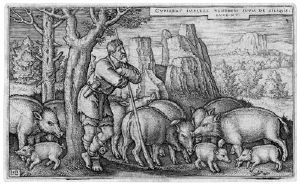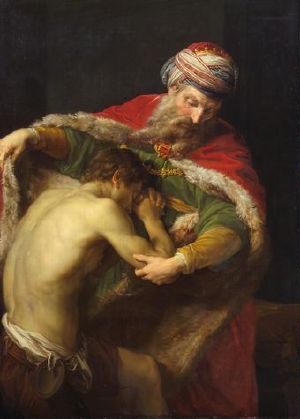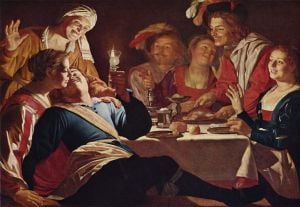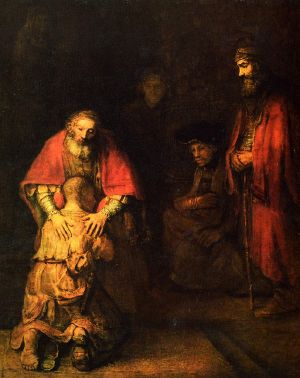The Prodigal Son, also known as the Lost Son, is about the inner nature of grace, and the transcendent and insuperable power of parental love. It is one of the best known parables of Jesus. It appears only in the Gospel of Luke, in the New Testament of the Bible. By tradition in the Catholic Church, it is usually read on the third Sunday of Lent. It is the third and final member of a trilogy, following the Parable of the Lost Sheep and the Parable of the Lost Coin.
These three parables address not only Jesus' reaction to the lack of acceptance from the Jewish leaders, but also the extension of his ministry to those not considered righteous or ritually clean by traditional Jewish standards. It is part of the Lukan concern with extending God's providence beyond the Jewish faith, as well as Luke's greater concern with the social expression of the gospel message. The Gospel of Luke contains 17 parables that are not contained in the other synoptic gospels. These parables are thought by scholars to come from Luke's own unique source material, although the origin of that material is unknown.
The parable is one of the clearest expressions of the Christian concepts of salvation and grace. The father rejoices over the return of the lost son, showering him with his unmerited love.
Overview
The story is found in Luke 15:11-32. The chapter begins with the Pharisees complaining that Jesus was receiving tax collectors and sinners. Jesus responds by telling the three parables. The third, the parable of the prodigal son tells the story of a man who has two sons. The younger demands his share of his inheritance while his father is still living, and goes off to a distant country where he "waste[s] his substance with riotous living." After he has squandered his inheritance, a great famine strikes the land, and in order to survive he has to take work as a swine herder and is even envious of the swine's feed, since "no one gave him anything." (Clearly the swine reference is a sign of the depth of his degradation, as swine are not kosher under Jewish law.) There he comes to his senses, and decides to return home and throw himself on his father's mercy because, he reasoned, even his father's servants had food to eat and he was starving. But when he returns home, his father greets him with open arms, and hardly gives him a chance to express his repentance; he instructs his servants to bring the best robe, a ring for his finger and shoes for his feet, and to kill a fatted calf to celebrate his return. However, the older brother becomes jealous at the favored treatment of his faithless brother and upset at the seeming lack of reward for his own faithfulness. But the father responds:
Son, thou art ever with me, and all that I have is thine. It was meet that we should make merry, and be glad: for this thy brother was dead, and is alive again; and was lost, and is found.
(Luke 15:32, KJV)
The Eastern Orthodox Church traditionally reads this story on the Sunday of the Prodigal Son, which in their liturgical year is the Sunday before Meatfare Sunday and about two weeks before the beginning of Great Lent. One common kontakion hymn of the occasion reads,
I have recklessly forgotten Your glory, O Father;
And among sinners I have scattered the riches which You gave to me.
And now I cry to You as the Prodigal:
I have sinned before You, O merciful Father;
Receive me as a penitent and make me as one of Your hired servants.
Pope John Paul II explored the issues raised by this parable in his second encyclical Dives in Misericordia (Latin for "Rich in Mercy") issued in 1980.
Analysis
Within the context of Luke 15, these three parables—the Lost Sheep, the Lost Coin, and the Lost Son—make up a narrative unit. The three parables are offered in response to the complaints of the Pharisees that Jesus was consorting with unsavory characters.
The Pharisees' accusation was: "This man welcomes sinners and eats with them." They may have been referring obliquely to Psalm 1:1:
Blessed is the man
who does not walk in the counsel of the wicked
or stand in the way of sinners
or sit in the seat of mockers.
Parables
The Parables of Jesus have been the subject of numerous types of interpretive strategies. Of paramount importance is the role of narrative as a teaching technique. While there are numerous teaching sections in the Gospels, the number of parables suggests that it was a popular teaching device for Jesus. Narrative gives the hearer, both then and now, an immediate connection to the message, not one through the lens of ideology or theology, creating an identification with the characters in the story. The theological implications are secondary, to be inferred from the actions of the characters in the story. While the actions of the Prodigal Son drive the narrative along, it is the reaction of his brother and father that give the story its special significance.
The Role of the Elder Brother
Each of the three stories in the sequence is constructed on the theme of loss and rejoicing over what was lost. The Lost or Prodigal Son adds an extra narrative dimension, the character of the "faithful son" or "elder brother." This brother is disappointed or resentful at his father's embrace of the returning son. The parable implicitly compares the reaction of the Pharisees to Jesus' association with "tax collectors and sinners" to the reaction of the faithful son in the parable. His reaction to the Father's treatment of the prodigal son reflects a feeling of both injustice and rejection. His sense of justice is violated in that the seeming reward is given to the one who does not deserve it, while taking the reaction of the Father towards his brother as a rejection of his loyalty and devotion to the Father. Yet, because he cannot share in the Father's joy over the return of the lost son, it also demonstrates that he does not really share his Father's heart of love towards his own lost brother. Caught up in his own sense of place, he cannot embrace his own family member.
The Role of the Father
The Father in the story represents a higher dimension of love than does the elder son. He loves both of them, and thus his heart has been grieved at the loss of his second son. His exuberance over the return of the lost son overwhelms his concern for justice and position. From the Father's perspective his joy at the return of his lost son does not diminish his love for his elder son, although it seems that way from the elder son's perspective. The irony of this story, and one that is often overlooked, is that in embracing the second son, there is yet another loss, or distance created between the Father and the first son. In this manner, the story of first and second son is connected to the tradition of Cain and Abel, in which jealousy deprived the first father, Adam, of one of his sons. It also demonstrates that the wedge that was driven into that first family has not yet been completely overcome.
Christian Interpretation
The allegorical interpretation that is generally favored in Christianity sees in the Prodigal Son rebellious humankind who has strayed from God, wallowing in sin, graphically represented by the herd of swine. Like the Parable of the Lost Sheep and the Lost Coin, the rejoicing that is depicted is a symbolic representation of God rejoicing when the lost sheep or the lost son returns home.
The parable strongly contrasts the attitude of the two sons, the one who remained at home and faithful to the father, and the one who strayed and returned. The first is typically associated with the Pharisees while the second is associated with the sinners, with whom the Pharisees accuse Jesus of consorting.[1]
From the Jewish perspective, the elder son was entitled to the larger portion of the inheritance. As the one who remained faithful, he was doubly concerned that the father was slighting him in favor of the younger son who was undeserving of father's overwhelming response. The parable speaks to the Christian sense that God is a God of love and that he is seeking those that are lost. However, it does lead to the charge of lack of fairness on the part of the elder son, both which the father indicates that the elder son already has his reward. This rivalry between the two sons echoes the rivalry between enemy brothers in the Hebrew Bible.[2]
Representation in the arts

Visual arts
The story of the prodigal son has been depicted many times by later Christians, in many media. Of the thirty plus parables in the canonical Gospels, it was one of the four that were shown in medieval art almost to the exclusion of the others, but not mixed in with the narrative scenes of the Life of Christ (the others were the Wise and Foolish Virgins, Dives and Lazarus, and the Good Samaritan).[3] The Laborers in the Vineyard also appears in Early Medieval works. From the Renaissance the numbers shown widened slightly, and the various scenes—the high living, herding the pigs, and the return—of the Prodigal Son became the clear favorite. Albrecht Dürer made a famous engraving of the Prodigal Son among the pigs (1496), a popular subject in the Northern Renaissance, and Rembrandt depicted the story several times, although at least one of his works, The Prodigal Son in the Tavern, a portrait of himself "as" the Sonrevelingng with his wife, is like many artists' depictions, a way of dignifying a genre tavern scene. His late Return of the Prodigal Son (1662, Hermitage Museum, Saint Petersburg) is one of his most popular works.
Theater
The story was the most common subject of the English morality play, which is the precursor of Elizabethan theatre.
Notable adaptations for performance include a 1929 ballet by Sergei Prokofiev and an 1869 oratorio by Arthur Sullivan. Many of these adaptations considerably added to the Biblical material to lengthen the story; for example, the 1955 film The Prodigal took considerable liberties, such as adding a temptress priestess of Astarte to the tale.
Music
The parable has also often been revisited in songs, the length of which alleviates the need for additional material. More oblique adaptations include Prodigal Blues, a song by Billy Idol that compares the singer's struggles with drug addiction to the parable, and the musical Godspell, which re-enacts the Prodigal Son story as a Western film. Bono, the vocalist of the Irish band U2, wrote the song "The First Time" based on this parable. Musician Dustin Kensrue, also of Thrice fame wrote a song about the Prodigal Son entitled Please Come Home off the album of the same name released in 2007. The British heavy metal band Iron Maiden recorded a song, Prodigal Son, based on the parable of the same name, which appeared on their second release Killers in 1981. In 1978, reggae band Steel Pulse recorded a song entitled "Prodigal Son," which transposes the story of the prodigal onto the slave trade, and suggests that their real "homecoming" was in fact to be spiritual rather than physical, a "homecoming" through religion (Rastafari). (Edited By James Mariotti-Lapointe) The Reverend Robert Wilkins told the story of this parable in the song "Prodigal Son," which is probably best known as a cover version by the Rolling Stones on their 1968 album Beggar's Banquet. The Nashville Bluegrass Band recorded "Prodigal Son" as an a capella bluegrass gospel tune (which leaves out the brother).
"Juan en la Ciudad" (John in the City), a salsa-merengue fusion that describes the parable in condensed terms, was Richie Ray's and Bobby Cruz's most popular hit ever, in 1977.
Literature
Perhaps the most profound literary tribute to this parable is Dutch theologian Henri Nouwen's 1992 book, The Return of the Prodigal Son, A Story of Homecoming. In the book, Nouwen describes his own spiritual journey infused with understanding based on an encounter with Rembrandt van Rijn's painting of the return of the Prodigal. He shows how the story is illuminated by the painting and is really about three personages: the younger, prodigal son; the self righteous, resentful older son; and the compassionate father. Nouwen describes how all Christians—himself included—struggle to free themselves from the weaknesses inherent in both brothers and are destined to find themselves becoming the all-giving, all-forgiving, sacrificial father.
Notes
- ↑ See The Parable of the Prodigal Son In Christianity and Buddhism Retrieved December 28, 2008.
- ↑ See The Prodigal Son Retrieved December 28, 2008.
- ↑ Emile Mâle, The Gothic Image, Religious Art in France of the Thirteen Century, English trans. of 3rd edition (Collins, London, 1913 (and many other editions)), 195.
ReferencesISBN links support NWE through referral fees
- Holgate, D.A. Prodigality, Liberality and Meanness: The Prodigal Son in Greco-Roman Perspective. Sheffield, 1999. ISBN 9781841270258
- Phillips, T.E. Reading Issues of Poverty and Wealth in Luke-Acts. Lewiston, 2001. ISBN 9780889469136
- Pöhlmann, W. Der Verlorene Sohn und das Haus: Studien zu Lukas 15,11-32 im Horizont der Antiken Lehre von Haus, Erziehung und Ackerbau. Tübingen, 1993. ISBN 9783161459979
External links
All links retrieved November 2, 2025.
- The Parable of the Lost Son
- The Prodigal Son, comment by Rev. George Dimopoulos, Orthodox Portal
- Father Cantalamessa on the Prodigal Son
| |||||
Credits
New World Encyclopedia writers and editors rewrote and completed the Wikipedia article in accordance with New World Encyclopedia standards. This article abides by terms of the Creative Commons CC-by-sa 3.0 License (CC-by-sa), which may be used and disseminated with proper attribution. Credit is due under the terms of this license that can reference both the New World Encyclopedia contributors and the selfless volunteer contributors of the Wikimedia Foundation. To cite this article click here for a list of acceptable citing formats.The history of earlier contributions by wikipedians is accessible to researchers here:
The history of this article since it was imported to New World Encyclopedia:
Note: Some restrictions may apply to use of individual images which are separately licensed.


